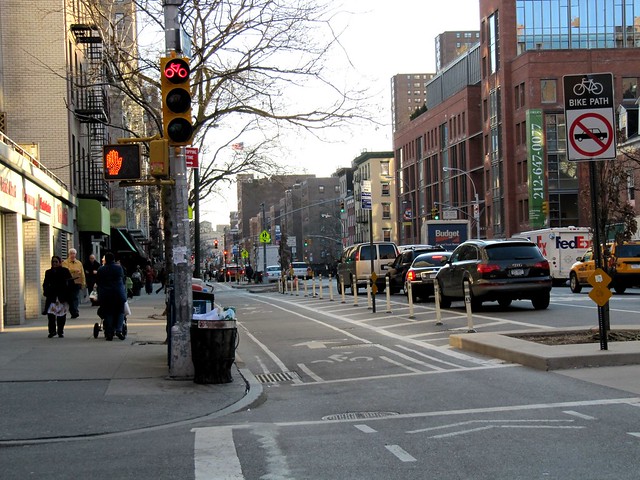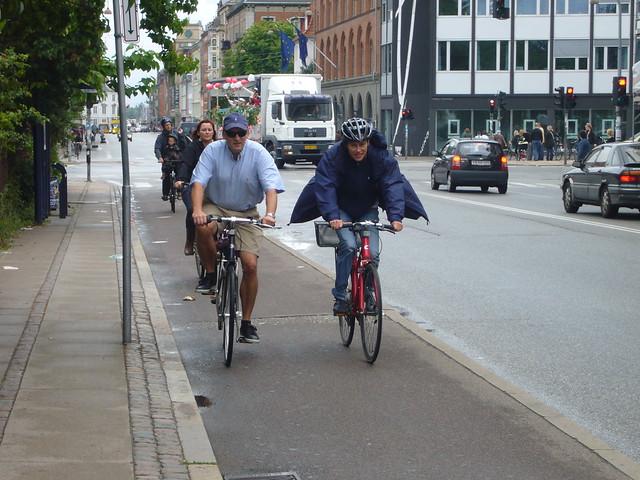Alan Heisey can't understand why some cycling activists are still hostile to separated bike lanes, given how common they are in other cities. So Heisey, who proposed separated bike lanes on Sherbourne Street at the City last year, provides us with an outline of some reasons why it is desirable to have a core network of continuous bicycle lanes separated from traffic in Toronto. I, however, think that Heisey has more to worry about the Mayor's opposition rather than some cyclists.
A. Torontonians Want Bicycle Lanes Separated from Traffic
A 2009 City of Toronto commissioned survey asked City residents if they wanted separated bicycle lanes on roads. 66% of all respondents most of whom would be motorists wanted separated bicycle lanes and 77% of commuting cyclists wanted bicycle lanes separated from traffic.B. Separated Bicycle Lanes Increase Pedestrian Safety
Separated bicycle lanes have been proven in New York City to significantly reduce serious pedestrian injuries on the streets they are installed in. See the New York Times in the last months on this issue. The evidence that bicycle lanes separated from traffic are safer for cyclists and pedestrians is irrefutable.In the Netherlands almost the entire network of bicycle roads is separated from traffic and the rates of injury and death for cyclists are lower than in Canada or North America even though most cyclists in the Netherlands don't wear helmets, which are ubiquitous in North America.
C. Encourage People who Are Afraid of Cycling Downtown to Ride Their Bicycles
This proposal is not for experienced cyclists it is for inexperienced cyclists who are too afraid to ride on our city streets, the vast majority of people in the City of Toronto. Even experienced cyclists feel differently when they have a small child on the back of their bicycle in not separated lanes. In London England a recent Transport for London study found that cycling is up 70 percent along routes where separated bike lanes were installed. 2010 figures from Montreal, which has a large network of separated bicycle lanes showed a 35-40% growth in bicycle ridership since 2008.D. Children will No Longer Have to ride Their Bicycles on Downtown Sidewalks
It is currently legal for bicycles with less than a 24 inch wheel to ride on the sidewalks downtown. The exemption is designed to permit children to ride legally on sidewalks. Once bicycle lanes are separated from traffic 8-12 year olds will be able to ride with their parents in safety on city streets and off of sidewalks.E. Most Major Cities Are Separating Bicycle Lanes from Traffic
Vancouver , Montreal and New York City all have extensive systems of separated bicycle lanes . Montreal leads the way in Canada with 78 kilometres of on-street separated bicycle lanes. Toronto has none. San Francisco installed its first separated bicycle lane on a public road in 2010. Separated on road bicycle lanes are common throughout European cities.F. The Bixi Bicycle Programme and Tourism
A network of separated bicycle lanes will support the investment the City of Toronto has made in the Bixi programme. In all other cities where Bixi has been introduced a network of separated bicycle lanes was created BEFORE the Bixi programme was launched. We got the cart before the horse. New tourists to our City will be more likely to use Bixi bicycles if they feel safe and they will feel safer with a network of separated bicycle lanes downtown.G. Bicycle Lanes are Continually Blocked by Illegally Parked Cars and Delivery Vehicles
Taxis are allowed to legally obstruct bicycle lanes stopping to pick up and drop off passengers. Canada Post is also legally allowed to obstruct bicycle lanes. The police will not effectively enforce illegal parking in bicycle lanes. There is only one way to prevent illegal parking in bicycle lanes it is to physically separate them with curbs or bollards so the lanes cannot be parked in. It is the only solution to illegal parking in bicycle lanes.H. Snow Removal in Bicycle Lanes
During winter, bicycle lanes are frequently blocked by snow. Councillor Denzil Minnan Wong is proposing that this network of bicycle lanes have snow removal.I. Passing Bicycles on Separated Lanes
The question of curbs or bollards has not been determined. If bollards are chosen the bollards would keep cars out of the lanes but let bicycles move around other cyclists. One of the proposals on the table is to put both of the lanes on one side of the street like in Montreal. This would permit cyclists to pass in the opposing lane of bicycle traffic. The proposal is for only 4 streets of the hundreds of streets downtown to have bicycle lanes separated from traffic. Those cyclists who want to be in car traffic will still have lots of roads to choose from. Those cyclists who want to have a route separated from traffic currently have no options whatsoever.
It makes sense to focus on a core, continuous network if we're going to start on improvements anywhere. No city, even in Europe, puts separated bike lanes on every street, but instead starts with some heavily trafficked areas. In New York City, for instance, the guideline is to only place them on streets with fewer intersections.


![Tue, 06/15/2010 - 12:01 - [Photo by Ray Van Eng] www.Youtube.com/rayvaneng and<br />
www.vancouver21.com Tue, 06/15/2010 - 12:01 - [Photo by Ray Van Eng] www.Youtube.com/rayvaneng and<br />
www.vancouver21.com](https://live.staticflickr.com/4062/4705070356_064e986fc1_z.jpg)

